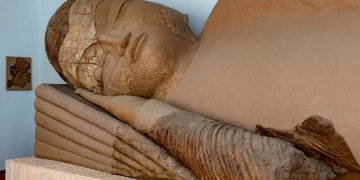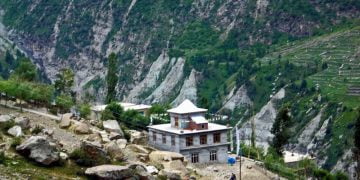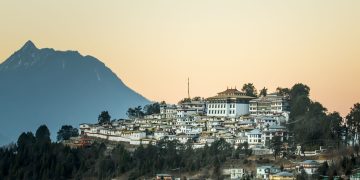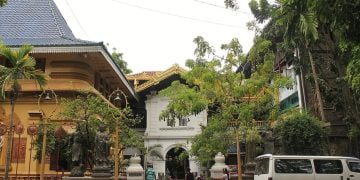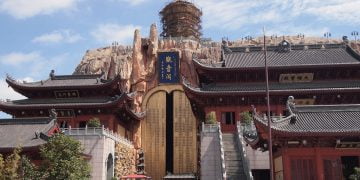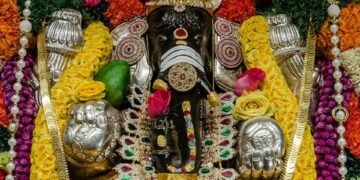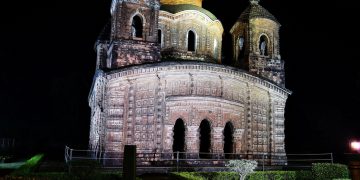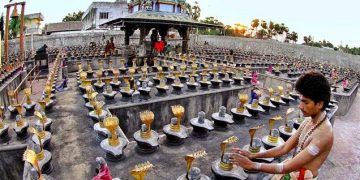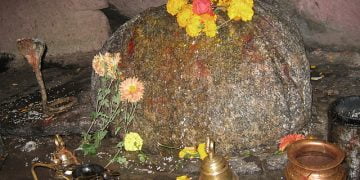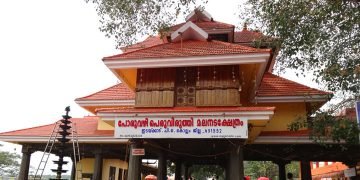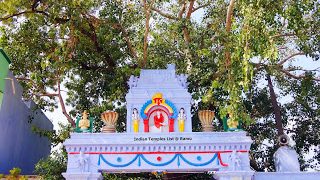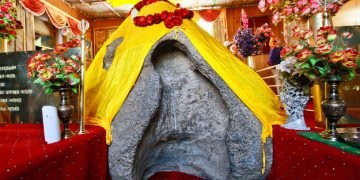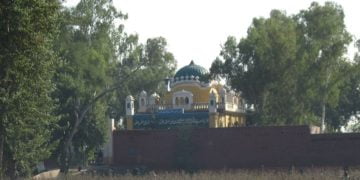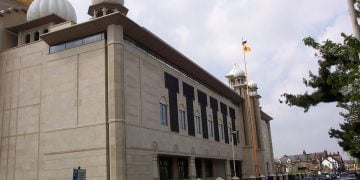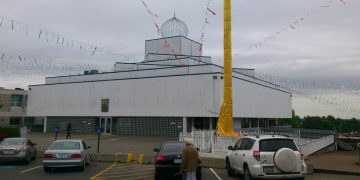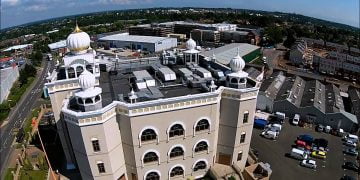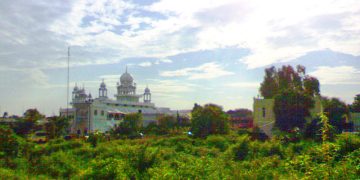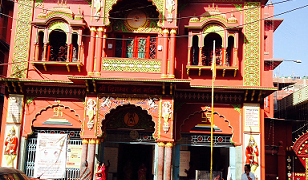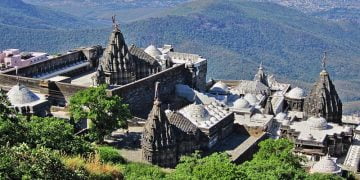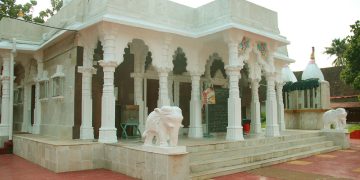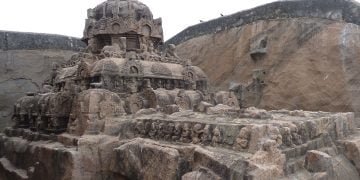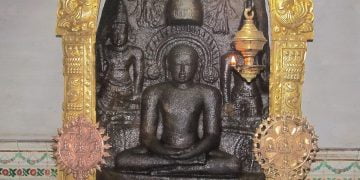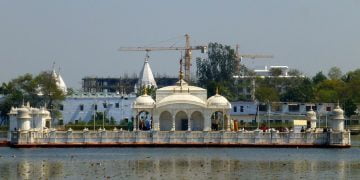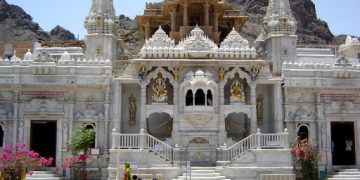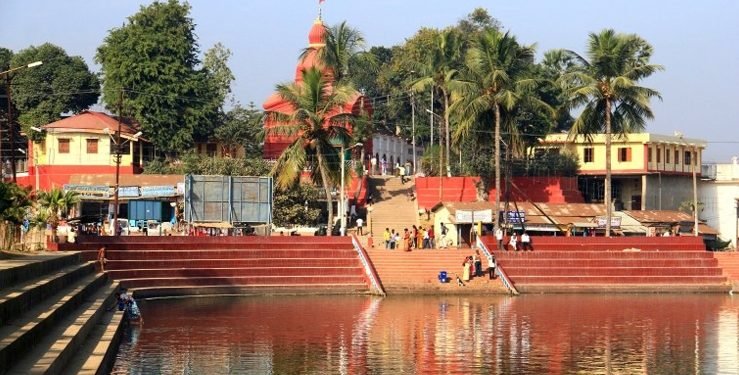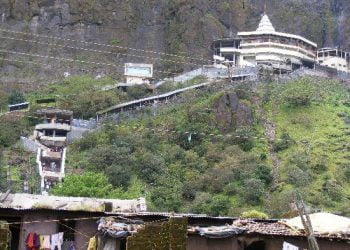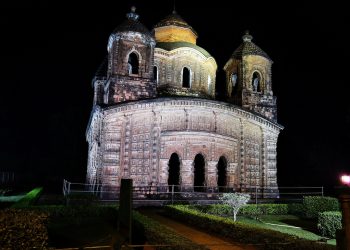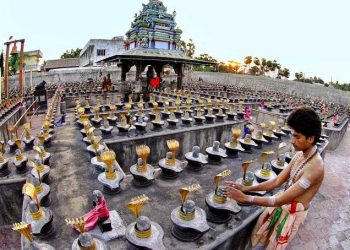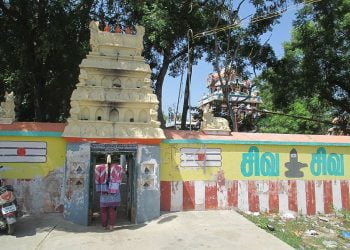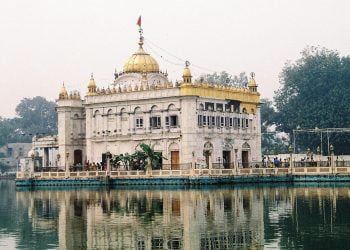Tripura Sundari Temple is situated in the ancient Udaipur, about 55 km from Agartala, Tripura believed to be one of the holiest Hindu shrines in this part of the country. Popularly known as Matabari, crowns in a small hillock and is served by the red-robed priests who traditionally, minister to the mother goddess Tripura Sundari.
Shrine’s History
There are certain common talks that prevails regarding the installation of the devi-idol. It is learnt that Maharaja Dhanya Manikya decided to bring the Shivalinga or phallic symbol of shiva from Chandranath, a place of pilgrimage at Chittagong, to his state when he came to learn about its divine grace and power.
Excavation began at full swing but eventually it was an unsuccessful attempt to dislocate it. One night the Maharaja perceived a divine message in his dream that the Shivalinga couldn’t be dislodged from its place, instead, the idol of Tripura Sundari could be translocated, if he wished. But there was a precondition that the idol could be shifted away anywhere as far as possible by the following night only and by no means it could be moved after the day break. According to the divine message, the Maharaja arranged for the transfer of Tripura Sundari idol. Servants loyal to the King toiled hard all the way to bring the idol but were forced to halt on the way when the idol became static as soon as day broke out. Maharaja Dhanya Manikya built a temple just at that place and installed the idol therein. The place was later named Matabari. Another hearsay is that, the present image of deity was actually found submerged under water of Brahmachhara nearby Matabari, The Maharaja perceived a divine message in his dreams to rescue the Devi. Thereafter, he built the temple. Matabari is located approximately 3 kms South to Udaipur town. The temple is built on a relatively small hillock which is convex shaped, almost like a tortoise (thus also referred as Kurmapitha). The temple was constructed on the top location of the tortoise shaped hillock. It is popularly known as the Temple of Tripura Sundari, Tripura Sundari or Matabari among the people of Tripura. In the course of time, the area adjacent to the Temple too was named as Matabari. Presently, the block also endorses the name Matabari. There is a big pond ‘Kalyansagar’ on the east of the temple. The pond dates back to the period of Maharaja Kalyan Manikya , i.e. it was dug up at least 124 years after the temple was founded.
Another big pond was said to be there, in the north of the temple Chandroday Vidyabinod, the expert of stone – inscription had seen the signs and remains of the pond in 1903 A.D. During the time, it was thickly covered with bushes and bore a deserted look. It is not yet evaluated, when and who had actually (lug the pond up. But owing to its proximity to the temple, it is assumed that the pond was dug after the temple stood up and probably it was dedicated to the Devi. Highlighting this, Chandroday Vidynbinod in his book ‘Shilalipi Samgraha’ quotes, ‘It is assumed that Maharaja Dhanya Manikya, founder of the temple had himself arranged for the excavation of the pond.’ In the north and east of the pond Is the ‘Sukhsagar’. Another pond in the west of the temple and ‘Sukhsagar Jola’ in the further west of it had been mentioned in ‘Shilahpi Samgraha’.
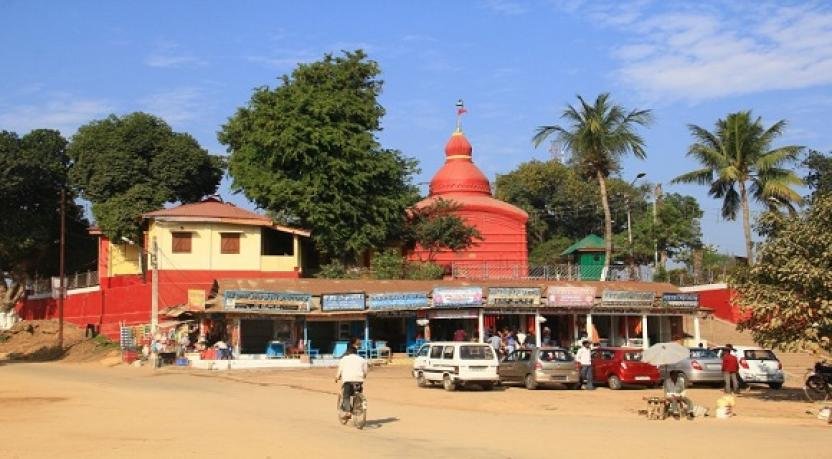
Legends Associated with This Shrine
Legend has it that king Dhanyamanikya who ruled Tripura in the closing years of the 15th century, had a revelation one night in his dream, ordering him to install Goddess Tripurasundari in the temple that stood on a hilltop near the town of Udaipur. The temple was already dedicated to Lord Vishnu, and the king was confounded initially, unable to decide how a temple dedicated to Vishnu could have an idol of the consort of Shiva. However, the oracle repeated the divine injunction to the king once again the following night, thereafter the ruler decided to obey the ethereal command, notwithstanding the fact that Vishnu and Shiva typified two different sects of religious following. Thus, the Tripura Sundari temple came into being in around the year 1501 and is now about 500 years old. This legend is recounted as one of the examples of how solidarity between the two subgroups, the Vaishnava and Shaiva sects, was known and fostered even during medieval times.

Architectural Relevance of This Shrine
The temple of Tripura Sundari or Matabari faces westward. Though the main entrance is in the west, there is a small entrance also in the north. According to Chandrodaya Vidyabinod Bhattacharya, the latter might have been carved out Construction in the later years. He observed that generally, the pattern of the ancient temples didn’t seem to have more than one entrance, The temple had been measured physically in 1892 A.D. which furnished the data that exterior of the temple was 24’x24′ and the inner compartment 16’x 16′. The temple wall had a width of 8′ and it was 75′ tall.
The difference in measurement between the outer and inner lies in the fact that the temple wall was exceedingly thick. Though the outer morphology of the temple is tetragonal, the core chamber or lumen inside is round just as the circular roof inside. Seldom such temples with spherical lumen are visible in India. There are four buttresses or supports at the four corners of the temple exteriorly. The horizontal carvings protruding at frequent intervals encircling along the buttresses enhance their beauty extensively. Intricate artistry resembling inverted pitcher beautifies the apex of the buttresses. Horizontal lines symmetrically joined by vertical lines at alternate intervals produce a texture of rectangles with different magnitudes all along the surface of the walls. The top of the temple is covered by four slanting roofs or Chaar chaalas that hold a circular block at the centre. There rests a conical or stupa like neck on the block and numerous small alcoves or Kulangi serially surrounding its base render it the look of a blooming lotus.
The neck beholds the Aanilok, a conical or a myrobalan shaped structure. Slender, convex undulatory curve lines along the Aamlok are distinctly visible from a distance. Aamlok is ascended by Karanda, a typical structure that resembles a flower-basket or a beehive that also bears the sacred flag on top. The apical portion of the temple is considered to be that of a modified form of the typical Buddhist stupas. A chaala-temple or a temple with slant roofs is a typical example of the Bengal architecture of the medieval period. Such a modified form of construction of a Buddhist-stupa on a tetrad roof or Chaar chaala is an unique phenomenon and seen nowhere in India. While such a pattern on four chaalas had evolved due to a blending of Hindu and Buddhist style of construction, there are certain accessory structures on the temple unseen in either Hindu or Buddhist architecture. Hindu temples don’t seem to have buttresses which are otherwise very prominent in Tripura Sundari temple. Regarding ‘buttresses’, in his book ‘Temples of Tripura’, Sri Adrish Bandopadhyay denoted them to be heavily inspired from Muslim towers or Minars. Though a blend of various forms of construction styles had influenced the Tripura Sundari Temple, yet, one can say Tripura can boast of this architectural wonder as its own.
Obviously, the architectural design of the temple is referred to as that of a Tripura-style of architecture. The temple had actually come up on a raised pucca terrace. According to ancient paintings of the temple, there used to be a roofed Naatmandir or open prayer hall for offering prayer and other devotional performances near the core-chamber of the temple. It was pulled down at its worn out stage during the reign of Maharaja Radha Kishore Manikya. The present day hail had been newly built by him in 1903-l904 AD.
The construction of the hall seems to be heavily influenced by Orissa-style of architecture. These are live stone slabs bearing inscriptions engrafted on the walls of Tripura Sundari temple. Among them, one is in the north and two each in the east and South. But there are no such inscriptions in the front side i.e. the west. The editor of ‘Rajmala’, Sri Kaliprasanna Sen way back in 1892 A.D. had seen a deep mark on the anterior part of the front door of the temple. He opined that once there might have been a stone inscription engraved or engrafted on that spot that eventually got damaged years ago. Possibly the scar might have been filled up and restored during the renovation in the later years. Probably such a task was carried out during the reign of Radhakishore Manikya. Although Radhakishore Manikya undertook the renovation work of the temple in 1904 A.D., no stone- inscriptions had been preserved as a proof, stated the ‘Rajmala’.
It is quite obvious that there ought to be some sort of stone- inscription or other marks depicting the founder’s name somewhere around the temple, and generally, such marks are found to be in front of temples. The Shilalipi Samgraha, in this respect, mentions ‘ It is beyond doubt that there were stone-inscriptions. In 1423 Saka Era Maharaja Dhanya Manikya built the temple and installed the idol of Goddess Tripura Sundari Kali and orderly placed a stone slab in Tripura Sundari Temple bearing a Sloka inscribed on it’. In fact, the ‘Rajmala’ bears the description of the Sloka. Both the stone slabs in the east have inscriptions on the same matter and both fragments are actually part of a single script. Though the stone inscription was in Sanskrit, Bengali script had been used for that. Most probably, the two stone inscriptions were installed in 1681 A.D. in the temple. It is mentioned in the inscription that Maharaja Dhanya Manikya in 1423 Saka Era (1501 A.D.) founded this temple and dedicated it to Devi Ambika. Ram Manikya Dev carried out the renovation work of the temple in 1603 Saka or 1681 A.D. after it had been struck by natural calamities . Go to Top In the year 1603 Saka or 1681 A.D. Ram Manikya Dev, expired.
During the period, Balibhim Narayan used to be very powerful. He enthroned his nephew Rudra Manikya who was just four at the time and himself became the Prince. Balibhim used to look after the royal duties and probably that’s why the temple had been renovated under his guidance in 1681 A.D. Among the two stone inscriptions one was written in Bengali. It mentions the name of Dhanya Manikya, Ranagan, Ram Manikya and Dharmaraj. It depicts the construction period as 1423 Saka Era. The last thing written was the year ‘1603 Saka Era’. This stone- inscription too was engraved in 1681 A.D. It becomes clear from this stone inscription that following the construction of the temple by Dhanya Manikya, its first renovation had been carried out by Ranagan. Ranagan was brother-in-law of Udai Manikya and also the General. He was popularly known as Ranagan Narayan and he was alive even after the death of Maharaja Udai Manikya in 1489 Saka Era . Possibly the temple had undergone the facelift operation by Ranagan only after the death of Udai Manikya. The second stone inscription in the south tells us that Queen Sumitra Jagadishwari had carried out a renovation work of the temple in 1269 Tripura Era (1857 AD.). Regarding the pattern of construction of the temple, the ‘Shilalipi Samgraha’ states- ‘Tripura Sundari temple has been built in the style of the ‘Joykail temple’ at Kalighat’. Inspite of few similarities in their style the statement can’t be accepted because the temple at Kalighat had been built (1806-1809 A.D.) 305 years after the Tripura Sundari temple. Thus, it is obvious that Oldest the construction of Tripura Sundari Temple was not among the inspired by that of the Kalighat, instead, the latter had old Temples absorbed a lot from the former.
The temple of Tripura Sundari is older than both the Kalighat temple as well as the temple of Kamrup Kamakhya at Guwahati. Kamakhya temple was founded by the king of Koch Nara Narayan and Chilla Ray in 1565 A.D. Among the three pitha-temples in the eastern India, the temple at Udaipur is the most ancient. The deity of Goddess Tripura Sundari or Tripur Sundari which adorns the temple is made up of touch-stone. The of height of the idol is 1 meter 57cm and its width is inside the temple 64 cm. It is being installed on a stone-altar. The Devi or the Goddess bears two pairs of forelimbs which depicts typical gesture or Mudra of Devi.
According to scriptures, the upper right hand exhibits Varmudra or a gesture of blessing. The lower right hand exhibits Abhaymudra or a gesture of trust and assurance. The left forearm holds a Kharag or a Faichion; whereas, the lower arm holds an Asur-Munda or a head of a demon. But, these features are not distinctly visible in the present idol. The Devi wears a, Joga-mukut (a ‘crown on matted hair’) which conceals the tufts of undulating matted hair that flow down bilaterally. She wears a Munda-mala or a wreath of 13 severed heads. Her face is oval with a small flat nose and a pair of relatively small round eyes. The well shaped structure of the idol radiates the kind of charm that is unprecedented. She stands upright on the idol of Shiva that lays in Shavasana. Five mundas are supposed to be engraved on the surface of the altar which bears the Devi.
Shrine’s Map Location and How to Go There
By Road
Well-linked by road from Tripura, Tripureshwari Temple has no hurdle having the direct access of road transportation such as Taxis, Buses and etc. to its adorers.
By Rail
Now Tripura is connected by rail. Earlier, the nearest rail station is Kumarghat on N. E. Railway is 1475 km. from Kolkata via Guwahati and 140 km. from Agartala.
By Air
The nearest airport to reach Tripureshwari Temple is Agartala.
Shrine Timings
All Days Open 06.00 a.m. Close 10:00 p.m.
Events Celebrated at This Shrine
Every year on Diwali, a mela is organized in that place which is very much famous. More than lacs of people from different places including different states also visit this mela and whole night they enjoy it. It is held for one day only. A different kind of sweet is specially made here to worship Maa Kali. Its taste is so different from other places and is also known as Pera.
Extra Information About this Shrine
Tourist Attraction All though the shrine draws devotees of all denominations and sects all year round including some foreigners who are fascinated by the tribal heritage of Tripura and adjacent states of the Northeast, the crowds are particularly thick during Deepavali or Diwali when a major fair turns the place into a tourist attraction.
Animal Sacrifice The offering of animal sacrifices is a very popular custom. Goats are brought with garlands round their necks, as offerings. A notice board lists the charges for buffalo sacrifices, but these are obviously rare today.



